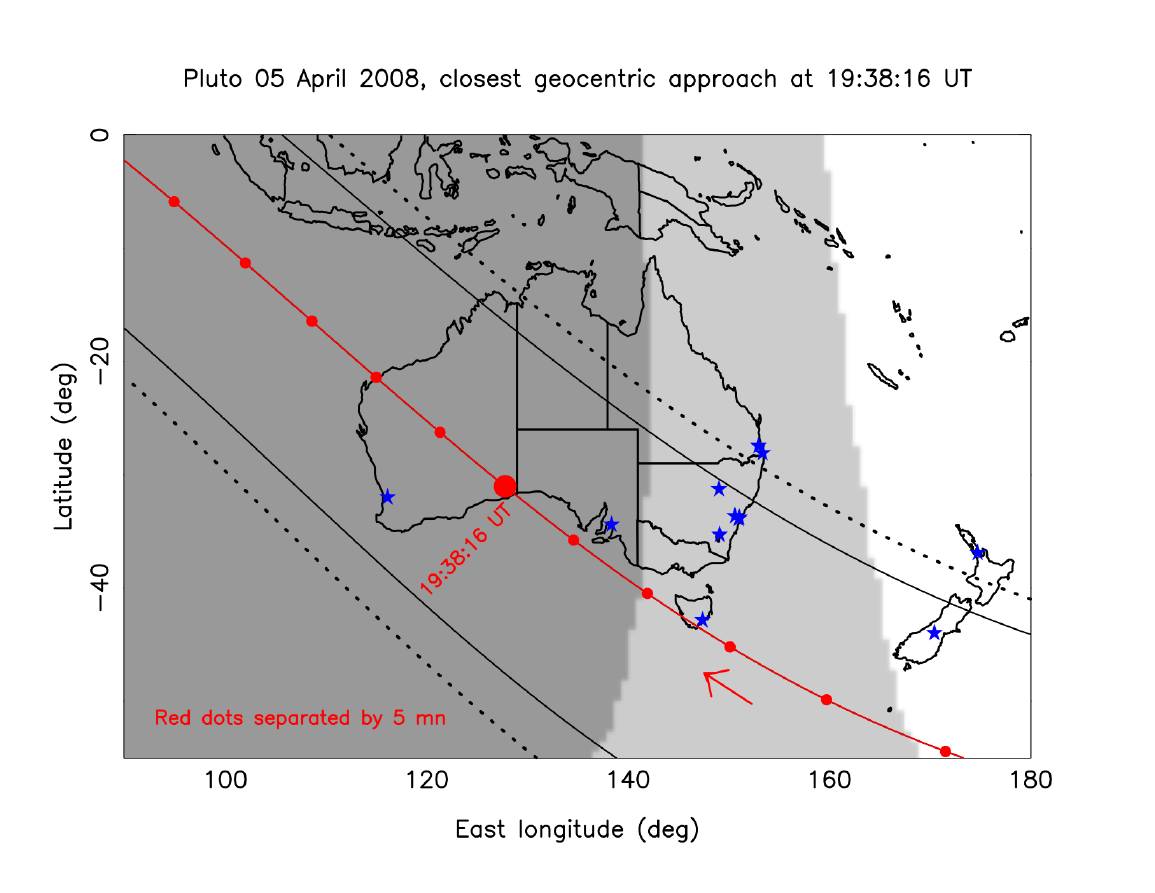| |
|
click |
click |
The Pluto stellar occultation of 05/06 April 2008
(visible from Australia).
On 05 April 2008 near ~ 19:20-19:50 UT (night 05/06 April 2008 UT), Pluto may occult a star, as seen from Australia. This event is remarkable because it is close to the planet station in the sky. Consequently, the shadow velocity is very low, about 2.45 km/sec, corresponding to a maximum duration of occultation of 21 mn for stations near centrality. The star is faint and occultation contrast is low (~5%), see below, but 10 sec exposures can still detect the event. This does not require fast cameras, as usually needed for nominal shadow velocities which almost ten times larger.
The main scientific goal is to see how Pluto's offset wrt DE413 ephemeris has evolved since 2007. This is possible even with moderate SNR light curves. This would be the first occultation observed for Season 2008, and pinning down Pluto's offset in 2008 would be most useful to better plan later Pluto occultations, involving brighter stars. Note also that some stations could be close to centrality, where a "central flash" caused by focusing of light by atmospheric layers of the planet can cause a surge of signal, typically 100 km around the centrality (see the red line on maps below).
Coordinates of star, from Dario da Silva (Rio de Janeiro group):
r.a.= 18h 04mn 16.1620 sec
dec.= -17d 03' 35.933" (ICRF J2000)
| |
|
click |
click |
NB. Black lines: Pluto half-light shadow, dotted lines: Pluto atmosphere 1% drop shadow (barely detectable). Red line: centrality of event (maximum duration, about 20 mn). Red dots in the center line are plotted every 5 mn, shadows move from right to left. Left panel: darker grey is for astronomical night (Sun 18 deg. below horizon), lighter grey is for astronomical twilight, and white zone for day time. Right panel: as Earth rotates during the event, a more accurate timing is shown on a planisphere, where Earth rotation during the passage of the shadow has been accounted for. (Note that New Zealand is in daytime).
NB. Uncertainty is still about +/- 800 km, i.e. about +/- one third of the total occultation band width on Earth.
An offset of Pluto's system of
-100 mas in right ascension (toward celestial west) and
+60 mas (toward celestial north) has been applied to Pluto's DE413 ephemeris.
This offset has been observed during the stellar occultation of 18 March 2007,
and again during the 12 May 2007 and 14 June 2007 events.
!!! **
IF THIS OFFSET IS MAINTAINED ON 05 APRIL 2008, THEN WE OBTAIN THE MAPS ABOVE..
** !!!
However, this offset is not currently understood, so any effort to update the astrometry is most welcome!!!
Star magnitudes, from Pic du Midi Observatory (Jean Lecacheux and Francois Colas):
| Star magnitudes: | V= 18.1 +/- 0.3 | R= 17.4 +/- 0.3 | I= 16.5 +/- 0.15 |
| Pluto/Charon: | V= 14.4 | R= 13.9 | I= 13.5 |
Thus, the occultation depth should be about 5-6 % in I band, and about 3-4 % in R band. THIS SHOWS THE DIFFICULTLY OF DETECTION. However, 1-m class telescopes with exposure times of 10 sec or so might still detect the event.
Field of view (from Pic du Midi):
Left panel: FOV Pic du Midi 1m Telescope. North is up, East is left. The target is at center of FOV. Inner circle has a diameter of 30 arcsec, outer circle has a diameter of 1 arcmin. Note the brighter neighbor star at PA ~ 120 deg., 6 arcsec from the target. This neighbor star should have a flux comparable to Pluto's. Right panel: Enlargement showing Pluto's positions (red dots) 48h, 24h before occultation and during the occultation.
| click |
click |
For contacts, more information and/or comments, you can contact me email at:
bruno.sicardy@obspm.fr